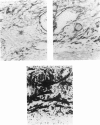Abstract
Photodynamic therapy (PDT) involves the interaction of light with an administered photosensitising agent to produce cellular destruction. It has promising potential for the local and endoscopic treatment of gastrointestinal cancer. There is however little data on the response of normal intestine to PDT. We have investigated the use of a new photosensitiser chloro aluminum sulphonated phthalocyanine (AlSPc) for colonic PDT. The peak concentration of AlSPc in the colon measured by alkali extraction occurred 1 h after i.v. injection. The cellular uptake demonstrated by laser fluorescence microscopy was greater in the mucosa than in the muscle. AlSPc was activated in the tissues by light from an argon ion pumped dye laser at 675 nm. The laser power was set at 100 mW and the fibre placed touching the mucosa. In control animals no macroscopic damage was seen. Temperature measurement using a microthermocouple array showed no temperature rise during light exposure. The energy (fluence), dose of sensitiser and time from sensitisation to phototherapy were altered and the area of necrosis measured. The geometry of the colon made theoretical analysis of the correlation between laser energy and size of lesion difficult. However, following direct measurement of the relative light intensity (fluence rate) in the colon we were able to confirm that there was a threshold fluence for colonic necrosis. The area of photodynamic damage seen 72 h after phototherapy fell with the fall in tissue concentration of AlSPc from 1 h to 1 month after i.v. injection. However, maximum tissue necrosis occurred when treatment was performed immediately after i.v. injection. In this situation, intense vascular spasm was seen and any light transmitted through the colon which fell on the small bowel mesentery caused a lethal ischaemic necrosis. The initial histological changes after PDT were vascular, followed by full thickness necrosis at 72 h. Healing by regeneration was complete by 2-3 weeks. Despite full thickness necrosis there was no reduction in the colonic bursting pressure at any time. Colon treated by hyperthermia had a reduced bursting pressure. Specific collagen stains showed that PDT did not alter the submucosal collagen architecture whereas hyperthermia did.
Full text
PDF







Images in this article
Selected References
These references are in PubMed. This may not be the complete list of references from this article.
- Berenbaum M. C., Hall G. W., Hoyes A. D. Cerebral photosensitisation by haematoporphyrin derivative. Evidence for an endothelial site of action. Br J Cancer. 1986 Jan;53(1):81–89. doi: 10.1038/bjc.1986.12. [DOI] [PMC free article] [PubMed] [Google Scholar]
- Bown S. G., Tralau C. J., Smith P. D., Akdemir D., Wieman T. J. Photodynamic therapy with porphyrin and phthalocyanine sensitisation: quantitative studies in normal rat liver. Br J Cancer. 1986 Jul;54(1):43–52. doi: 10.1038/bjc.1986.150. [DOI] [PMC free article] [PubMed] [Google Scholar]
- Chan W. S., Svensen R., Phillips D., Hart I. R. Cell uptake, distribution and response to aluminium chloro sulphonated phthalocyanine, a potential anti-tumour photosensitizer. Br J Cancer. 1986 Feb;53(2):255–263. doi: 10.1038/bjc.1986.43. [DOI] [PMC free article] [PubMed] [Google Scholar]
- Dickson J. A., Calderwood S. K. Temperature range and selective sensitivity of tumors to hyperthermia: a critical review. Ann N Y Acad Sci. 1980;335:180–205. doi: 10.1111/j.1749-6632.1980.tb50749.x. [DOI] [PubMed] [Google Scholar]
- Henderson B. W., Waldow S. M., Mang T. S., Potter W. R., Malone P. B., Dougherty T. J. Tumor destruction and kinetics of tumor cell death in two experimental mouse tumors following photodynamic therapy. Cancer Res. 1985 Feb;45(2):572–576. [PubMed] [Google Scholar]
- Kinsey J. H., Cortese D. A., Neel H. B. Thermal considerations in murine tumor killing using hematoporphyrin derivative phototherapy. Cancer Res. 1983 Apr;43(4):1562–1567. [PubMed] [Google Scholar]
- Moan J. Porphyrin photosensitization and phototherapy. Photochem Photobiol. 1986 Jun;43(6):681–690. doi: 10.1111/j.1751-1097.1986.tb05647.x. [DOI] [PubMed] [Google Scholar]
- Moan J., Steen H. B., Feren K., Christensen T. Uptake of hematoporphyrin derivative and sensitized photoinactivation of C3H cells with different oncogenic potential. Cancer Lett. 1981 Dec;14(3):291–296. doi: 10.1016/0304-3835(81)90157-9. [DOI] [PubMed] [Google Scholar]
- Nelson J. S., Wright W. H., Berns M. W. Histopathological comparison of the effects of hematoporphyrin derivative on two different murine tumors using computer-enhanced digital video fluorescence microscopy. Cancer Res. 1985 Nov;45(11 Pt 2):5781–5786. [PubMed] [Google Scholar]
- Rosenthal I., Murali Krishna C., Riesz P., Ben-Hur E. The role of molecular oxygen in the photodynamic effect of phthalocyanines. Radiat Res. 1986 Jul;107(1):136–142. [PubMed] [Google Scholar]
- Selman S. H., Kreimer-Birnbaum M., Goldblatt P. J., Anderson T. S., Keck R. W., Britton S. L. Jejunal blood flow after exposure to light in rats injected with hematoporphyrin derivative. Cancer Res. 1985 Dec;45(12 Pt 1):6425–6427. [PubMed] [Google Scholar]
- Spikes J. D. Phthalocyanines as photosensitizers in biological systems and for the photodynamic therapy of tumors. Photochem Photobiol. 1986 Jun;43(6):691–699. doi: 10.1111/j.1751-1097.1986.tb05648.x. [DOI] [PubMed] [Google Scholar]
- Star W. M., Marijnissen H. P., van den Berg-Blok A. E., Versteeg J. A., Franken K. A., Reinhold H. S. Destruction of rat mammary tumor and normal tissue microcirculation by hematoporphyrin derivative photoradiation observed in vivo in sandwich observation chambers. Cancer Res. 1986 May;46(5):2532–2540. [PubMed] [Google Scholar]
- Tralau C. J., MacRobert A. J., Coleridge-Smith P. D., Barr H., Bown S. G. Photodynamic therapy with phthalocyanine sensitisation: quantitative studies in a transplantable rat fibrosarcoma. Br J Cancer. 1987 Apr;55(4):389–395. doi: 10.1038/bjc.1987.78. [DOI] [PMC free article] [PubMed] [Google Scholar]
- Weishaupt K. R., Gomer C. J., Dougherty T. J. Identification of singlet oxygen as the cytotoxic agent in photoinactivation of a murine tumor. Cancer Res. 1976 Jul;36(7 Pt 1):2326–2329. [PubMed] [Google Scholar]





